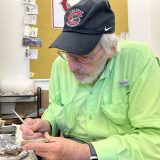
New Chocolate Quality and Flavor in the Works by Kelly Sparks, MS in Food Science student
April 25, 2016
Contrary to popular belief, chocolate bars are not made from a flowing, brown river. I’m looking at you for blame, Willy Wonka.
You won’t even find a chocolate tree, as they are just as rare as money trees. And the Easter bunny does not actually lay chocolate eggs. I know, this sounds terrible, but please keep reading, for what I am going to tell you is the very truth about how chocolate is made, along with some secrets about chocolate and how there may be a new kind of chocolate in the near future. Yes! A new kind of chocolate. Your eyes read that right. But, before I get there, we must start at the beginning.
The Beginning
While chocolate does not grow on trees, cocoa pods do. These cocoa pods are harvested and the pods and pulp inside the cocoa pod are taken out. This is the start to making the dark, delicious treat we know as chocolate.
The Middle
The pods and pulp are contained together and then the pulp starts a fermentation process that lasts about a week. This step is important because it is where the flavor of chocolate first starts to develop. Keep this in mind.
This leads us to the drying stage. From here, we have dried beans, which are then roasted. The beans are roasted at high temperatures for a period of time. This plays a role in the flavor of the chocolate bar. The dried beans contain cocoa butter, amino acids (which are the building blocks of proteins), sugars, and antioxidants; so when heated, they move around and collide with each other (just like you would do if you were being roasted), and this results in chocolate-like flavors.
The roasted cocoa beans have a thin, paper-like coating around them, so a process called winnowing is done to remove them, leaving just cocoa nibs.
The cocoa nibs are grounded to reduce particle size until they form cocoa liquor, which is made up of cocoa solids and cocoa butter. A conching process then takes place, during which the cocoa butter is evenly distributed throughout the chocolate while and sugar, and milk powder (for milk chocolate), and other flavorings are added. This process may take a few hours up until a few days, and affects the flavor of the chocolate. It is said that higher quality, better chocolate is conched longer.
The temperature of the chocolate is raised, lowered, and then raised again so that the chocolate has a smooth mouthfeel and so you can hear a snap when you break a piece off.
The End
The chocolate is now what most of us consider chocolate, and it is now molded into any shape or design the chocolate manufacturer wants. Once the chocolate is cooled, it is wrapped and ready to be eaten by the customer (you)!
Fascinating. Oh yeah? The new kind of chocolate, don’t worry, I didn’t forget. This is the best part.
New Kind of Chocolate
So, recall one of the middle processing steps of chocolate: fermentation. During this stage, naturally present yeasts and bacteria ferment the gooey pulp. Remember, this stage is when the flavors of chocolate first develop. Well, research conducted by The University of Leuven and the Flanders Institute for Biotechnology, along with the chocolate brand, Callebaut, show that using specific yeast strains can provide a better quality final chocolate product with new flavors and aromas. Lead researcher in this study, Dr. Jan Steensels, said “the set of new yeast variants that we generated makes it possible to create a whole range of boutique chocolates to match everyone’s favorite flavor, similar to wines, tea, and coffee”.
Similar to beer and wine, which also undergo fermentation, chocolate will be able to have a wider spectrum of flavors and aromas, ranging from a more fruity chocolate to a more sour chocolate. This means that we can match our favorite beer flavor with a complementary chocolate flavor. Or just have the new chocolate flavor by itself as a snack because it’s chocolate and doesn’t need to be paired with anything. The choice is yours. But for now, you can look forward to and dream about a new kind of chocolate.
This article is part of our on-going series “The Science of Food” which is comprised of essays from students in the M.S. in Food Science program at Chapman University. The essay was originally published on the Food Science Student Association’s blog, which you can read here: http://chapmanfsnsa.blogspot.com/.

